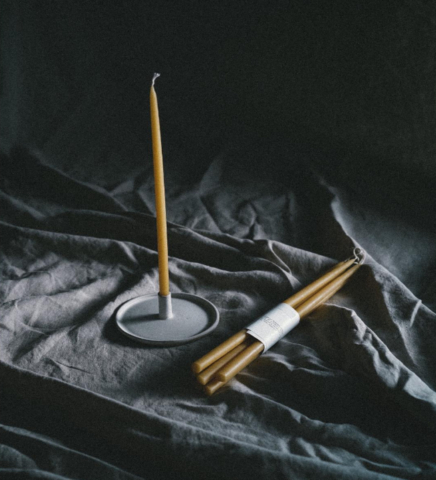Light with Scent
By Jo Phillips
It’s probably hard for any of us to know what it must have felt like to live in a world that didny have electric lights. But there was a time when light came into a room only from the sun or via candles. The history of candles is quite surprising seeing as many of us enjoy today a beautiful scent wafting without thinking too much about how we come to be able to enjoy candles rather than rely on them as an essential. Driven by social snobbery and strick social etiquette there is far more to this elemental light than first meets the eye. Find out more in Light with Scent here.
One of the biggest changes in domestic life without a doubt would have been the birth of electric light in the late nineteenth century. Although initially, it would only be rich households that could have afforded it, eventually it seeped down to all. Until then though, all houses would have been lit with candles. Now that may sound very fun and fairy-like but if you were not wealthy then the smell would have been quite horrid and putrid.
Something called a rushlight was the poor person’s light source. Basically made up by repeatedly coating a rush (grasses) in hot fat, building up the layers to create a rather sad version of a candle. To double the illumination, both top and bottom could be light, well you now know where the phrase ‘burning the candle at both ends’ comes from. After all, these were extremely expensive, especially as they would only burn for around 20 minutes a time.

Another cheaper alternative was the tallow candle. Made from animal fat of sheep or cows because pig fat not only smelt terrible but made for black smoke as it burned.
Far more elegant Beeswax candles, also very expensive to use were only for the rich. Interestingly the ends of the candles that were not used were given to the most senior servants.
The Hall of Mirrors at the infamous Versailles Palace was the first room in history to be illuminated with glass used to reflect candlelight, which meant far more parties in an evening.

Oil lamps came next in history but these also emitted horrid smells and dark soot. Even with the advent of glass ‘lampshades’, again fine for the rich as they had servants to clean the glass.
Gas came next, making its appearance in factories, theatres and street lighting long before entering homes. By the 1840s it’s fair to say most middle-class homes had this form of lighting, but it was still seen a bit like ‘keeping up with the Joneses’ or a form of social climbing. It did however come with problems like using up oxygen in a room in order to burn and many a fire was caused by its presence.

It was only in the 1880s that electricity arrived causing a real stir. Immensely expensive with a light bulb costing as much as an average week’s wages. Alongside the cost, homes also needed their own generator.
Yet again it was the millionaires who were able to install generators in their houses. A certain society lady in NYC, Mrs Cornelius Vanderbilt even went to a costume ball as Electric Light. The widespread use of electricity was delayed until such times as standardised generators and ultimately a national grid, the 1930s!
Yet the art of candle making never left. What a candle can do is so very different to electric light. Firstly mood and then scent. Scented candles have been around for a long time and it is believed in China, incense sticks were often inserted into candles giving a divine scent, whilst, in India, candles were boiled in cinnamon and therefore, carried a marvellously sweet and pleasing scent.
Take for example what was going in throughout this period in Paris. In 1884, the Carrière brothers decide to buy the company The Royal Wax Manufacture, known then as Trudon. Respectful of tradition, yet eager to innovate, they created Carrière Frères.

They extend the religious use of candles to include them as decorative objects: a new generation of pillar and taper candles would have been seen on diner tables of the wealthy or favoured by the gentry during festivals.
Eager to innovate, the Carrière brothers modernize the profession’s manufacturing secrets, drawing inspiration from the 18th century’s many scientific endeavours and discoveries. They follow the works of botanists and explorers, the fate of far-flung expeditions; through them, they uncover unknown latitudes and rare plants. These exploratory missions become an endless source of stimulation for the manufacturer.
Paying tribute to botanical research, still today, Carrière Frères is organized around a table of scents that epitomize the natural biodiversity of the plant kingdom: the scented candles group as a range of single note-like perfumes that include exotic, indigenous and aromatic essences unveiled by 18th-century’ botanists and explorers.
Yet it wasn’t until the 1980s that the popularity of candles began to rise again. They became, once again, luxury items and design-led candles with coloured wax and decorated jars began appearing. A decoration more than anything and then came along the scent story for the first time in thousands of years.
With waxes that no longer carried noxious odours fragranced candles began to appear. From natural garden scents to therapeutic oils added for mental benefits, scented wax now exists to help us relax, be uplifted and create a divine home environment.
For Carrière Frères’s key to their heart, is to embody the plant world within each and every product. Flowers, herbs, woods and fruits, each botanical treasure classified, closely studied in order to capture and recreate its full complexity in candles, botanical palets, diffusers and room sprays offers
The scented candles are made in France, in their workshop in Normandy according to exceptional expertise and are made of 100% vegetable wax, their Palet is also made there with again 100% vegetable wax, The differs Produced from 100% recycled glass and 100% natural alcohol as are the room sprays. All like a periodic tablet of natural scents bringing in the vibrant outside into our homes.

Exploring such flavours and smells like their amazing Tomato candle that explored the whole of the plant, this fleshy berry from the Solanaceae family of plants, the tomato takes its name from the deformation of the Inca word ‘tomalt’.
Or the Jasmine candle with its name comes from the Arabic ‘yâsamîn’, itself borrowed from Persian. The sweet-smelling flower grows on an Indian shrub of the Oleaceae family.
Find a range of botanical scents like spearmint, Bay, Lemon, Tea, Ginger, and Rosemary as well as a handful of delicious florals and fruits. The latest collection by Carrière Frères takes us to Japan to explore a special plant in the heady world of citrus.
Yuzu is a citrus fruit that grows on a small tree part of the Rutaceae family. Known by many as ‘Japanese lemon’, Yuzu is a natural hybrid of the Icheng lemon and the Mandarin orange, native to China. Utilised across East Asia in food and well as in scent its zesty juicy vibrant scent alive with facets of lime mandarin and orange alongside its lemony zest.

The new collection contains a candle as well as a room diffuser. The candle its top of zesty citrus notes finds soft underlying notes discreet tea facets and refined white flower petal notes and a light musk veil. The differ offers the same scent palette and comes with untreated rattan sticks, a recyclable cork stopper and 100% recycled and recyclable glass, that catches this vital bright scent.
We know scent can transport us in seconds, and being transported to the outdoors to either a garden of your own or a park far far away the scented candle or room spray with its tremendous history does just that for us. Quite impressive for a small pot of historic wax.
To find out more about carrierefreres.co.uk please visit the site here
If you enjoyed reading Light with Scent why not read Salt is Everything here
.Cent Magazine London, Be Inspired; Get Involved





